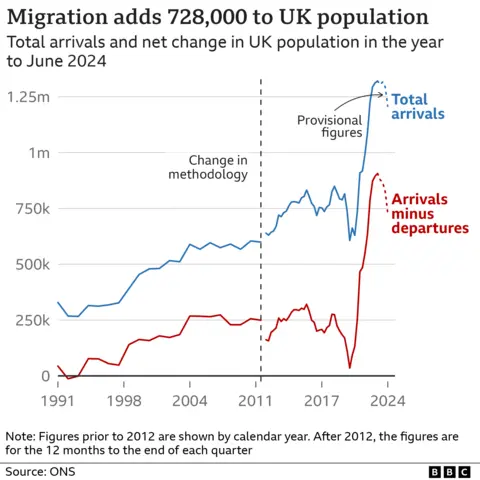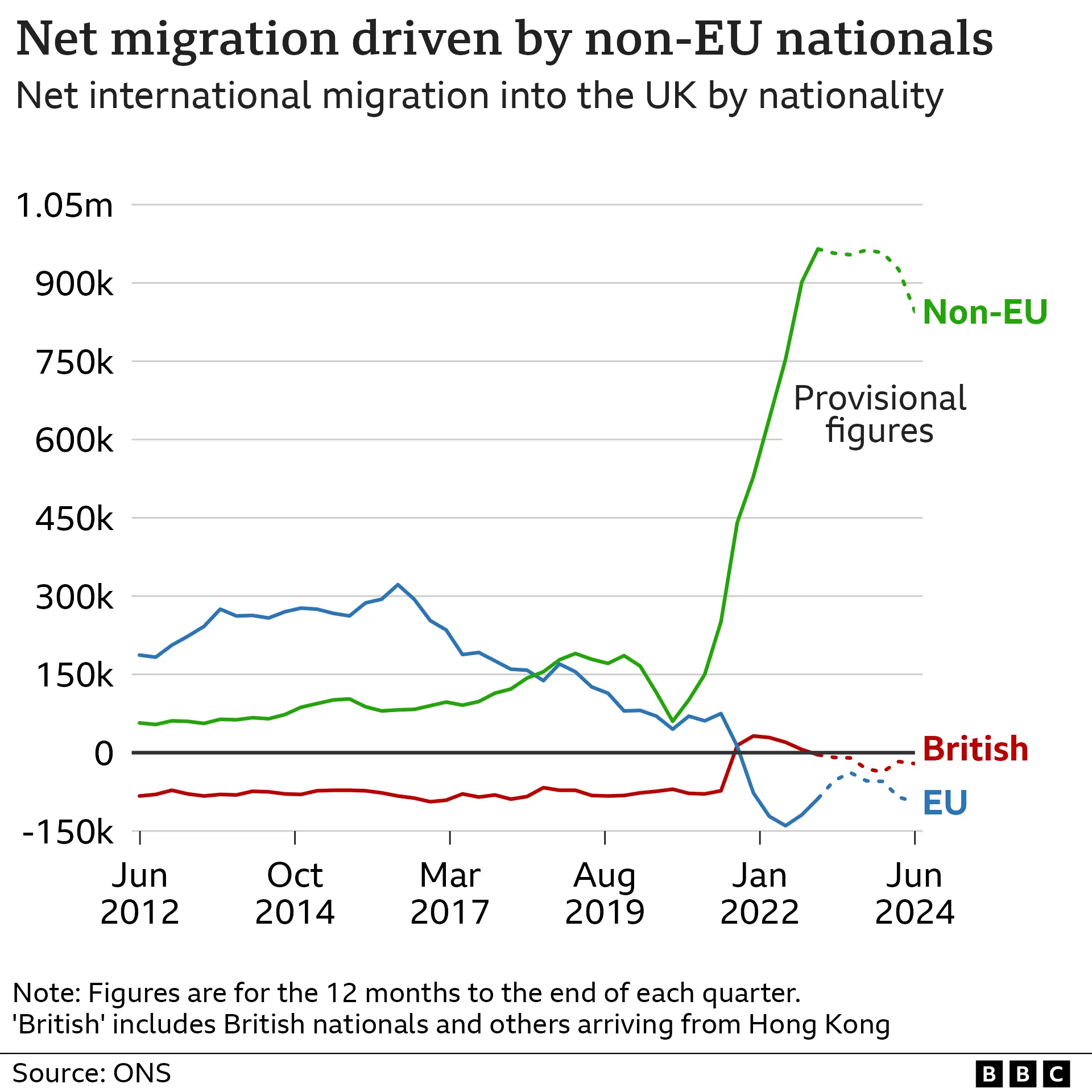Migration: How many people come to work and study in the UK and what are the rules?

 Getty Images
Getty ImagesOfficial figures show that 728,000 people came to the UK in the year to June 2024 – fewer than in the previous 12 months.
The fall was greater than expected because the estimated number of people who came in the year to June 2023 was revised up sharply, to 906,000.
How many migrants come to the UK?

The ONS figures show that of the 1.2 million people who came to live in the UK in the 12 months to June 2024:
- 5% (58,000) were British nationals
- 10% (116,000) were EU nationals or from Norway, Iceland, Liechtenstein and Switzerland (EU+)
- around 86% (1.0 million) were non-EU+ nationals
Of the 1.0 million non-EU+ nationals who came:
- 82% (845,000) were of working age (16 to 64 years)
- 17% (179,000) were children (under 16 years)
- 8% (84,000) claimed asylum, either after arriving via a regular route or arriving irregularly, for example, via small boats across the English Channel
Among non-EU+ migrants, the most common nationality coming to the UK for both work-related (116,000) and study-related (127,000) reasons was Indian.
What are the rules for student and graduate visas?
How have the salary rules for UK visa applicants changed?
What are the rules about family visas?
- spouse or partner
- fiancé, fiancée or proposed civil partner
- child
- parent
- relative who will provide long-term care for you
You have to demonstrate a good knowledge of English. The relative that you will live with in the UK has to meet the minimum income threshold.
This was initially also due to rise to £38,700 – a sharp increase from the previous £18,600 figure.
But after warnings the new rules risked separating families, the previous government dropped the new minimum to £29,000.
Anyone renewing an existing family visa does not have to meet the new earnings threshold.
Are fewer people coming to work in health and social care?
The Home Office statistics showed that 27,000 visas were issued to people coming to the UK to work in health and social care in the 12 months to December 2024.
This is a fall of 81% compared with the previous 12 months. The number coming to work in the sector had increased significantly after temporary changes to the health and care visa rules.
In the year ending December 2024, there were approximately three dependants for each person coming to do a job in health and social care.
However, the number of dependants fell sharply in the last 10 months of the period, after the previous Conservative government changed the rules to stop international social care workers bringing their children or partners with them.
How does the points-based system work?
What is the immigration salary list?
The immigration salary list replaced what was previously called the shortage occupation list.
It helps employers fill vacancies in key sectors.
These jobs have a lower salary threshold making it easier for applicants to gain enough points to get a visa.
The list includes:
 Getty Images
Getty ImagesEmployers used to be able to pay foreign workers 80% of the usual “going rate” to fill these positions.
But this lower rate was abolished for people applying after 4 April 2024.
What are the rules for seasonal workers?
- 43,000 horticulture workers
- 2,000 poultry workers
Seasonal workers can stay in the UK for up to six months for horticultural work, and from 2 October to 31 December each year for poultry work.
They cannot accept a permanent job or bring family members with them.
 Getty Images
Getty ImagesHow has Brexit changed immigration?
Before Brexit, EU and UK citizens had the freedom to live, work or study in any EU country without needing a visa.
However, this freedom of movement ended on 1 January 2021 when the UK left the EU.
In the 12 months to June 2024, the ONS figures showed that net migration for non-EU nationals – the difference between those arriving and those leaving – was 845,000.

In the same period, net EU migration was -95,000, meaning 95,000 more EU nationals left the UK than arrived.
Net migration of British nationals was -21,000, meaning more British people left the UK than came back.
Related
Llyods Recruiting Engineers In India After Slashing Jobs In UK
Lloyds Banking Group is planning to hire hundreds of engineers in India as the company plans to shift its employment opportunit
Major new funding for music acts that supercharged careers of…
£1.6m Music Export Growth Scheme to support 58 independent UK artists to tour the world Funding will boost UK’s creative industries – a key growth se
Well-loved restaurant chain to close 8 venues across UK as…
A BELOVED restaurant chain has announced it will close eight venues across the UK, scrapping 158 jobs in the process.Owners are pointing the finger at Labour's
US adds 151,000 jobs in February as unemployment rate ticks…
The latest figures published by the US Bureau of Labor Statistics today (7 March) came in below market expectations, with economists polled by













